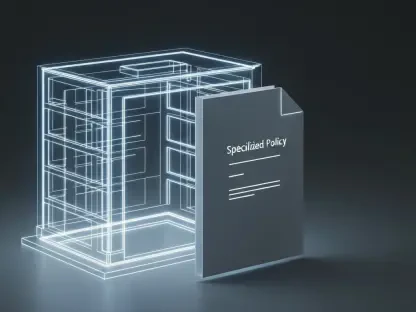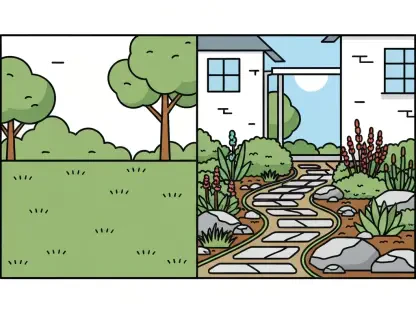As the construction industry grapples with mounting pressures to meet ambitious housing and infrastructure goals, Australia finds itself at a pivotal moment where artificial intelligence (AI) and robotics could redefine the future of building. With the National Housing Accord setting a target of 1.2 million homes over five years, alongside persistent labor shortages that threaten to derail progress, the urgency to adopt innovative solutions has never been clearer. Globally, technological advancements are transforming construction sites, turning them into hubs of efficiency and precision through automated tools and smart software. Yet, the question remains whether Australia can harness these breakthroughs to not only keep pace with international trends but also emerge as a frontrunner in this space. This exploration delves into the global surge of construction tech, examines Australia’s unique challenges and strengths, and outlines strategic steps to carve out a leadership position in a rapidly evolving field.
Global Momentum in Construction Technology
The construction sector worldwide is undergoing a dramatic transformation, fueled by an extraordinary influx of investment in AI and robotics, particularly in the United States. Billions of dollars are being channeled into practical innovations—think robots that handle layout and heavy lifting, or AI-driven software that streamlines scheduling and flags errors before they spiral into costly delays. A striking example is the $405 million funding secured by FieldAI, a testament to the confidence investors have in tech that delivers real, immediate impact on job sites. This financial backing isn’t just speculative; it reflects a shift toward solutions that tackle everyday inefficiencies, making projects faster, safer, and more cost-effective. For a country like Australia, observing this trend offers a valuable glimpse into what’s possible when capital and innovation align, providing a potential roadmap to accelerate its own technological integration.
Beyond mere funding, the involvement of major construction firms in the US sets a compelling precedent for industry-wide change. Companies are not passive adopters but active players, investing through venture arms and accelerators to test and refine new tools in real-world conditions. This collaborative model ensures that technologies are not just theoretical but practical, addressing tough challenges like uneven terrain or high-risk environments. The result is a rapid cycle of innovation where feedback from actual projects shapes the next generation of tools. For Australia, this builder-led approach highlights the importance of engaging local contractors in the tech adoption process, ensuring that solutions are tailored to specific needs rather than imposed as one-size-fits-all. Learning from this ecosystem could help bridge the gap between cutting-edge ideas and on-the-ground implementation.
Australia’s Unique Landscape of Challenges and Strengths
In Australia, the construction industry faces a distinct set of hurdles that make the adoption of AI and robotics not just beneficial but essential for meeting national goals. A constrained labor market poses a significant barrier, as relying solely on human resources to achieve housing targets is unsustainable, even with government initiatives like the Commonwealth’s apprentice bonus scheme offering financial incentives. Traditional methods of scaling up the workforce fall short when timelines are tight and demand is soaring. Technology offers a way to boost productivity, slashing build times and reducing errors through automation, thereby easing the burden on workers. Without embracing these tools, the risk of missed targets looms large, potentially stalling critical infrastructure and housing projects that communities urgently need.
Yet, amidst these challenges, Australia also holds remarkable potential to shine through homegrown innovation in construction tech. Local companies are already making waves with solutions like FBR’s Hadrian bricklaying robot, which automates a labor-intensive task with precision, and Roborigger’s crane safety system, enhancing on-site safety. These advancements signal a capacity for leadership, proving that Australian ingenuity can rival global standards. However, progress is hampered by systemic issues such as restricted access to construction sites for testing and a sluggish pace of adoption among firms hesitant to deviate from conventional methods. Addressing these roadblocks requires a concerted effort to create supportive frameworks that allow innovators to demonstrate the value of their tools in real-world settings, paving the way for broader acceptance and impact.
Strategies for Pioneering Construction Innovation
To stake a claim as a leader in construction AI and robotics, Australia must adopt strategic measures that integrate technology seamlessly into its building sector while addressing local nuances. One actionable approach is establishing “site labs” on public projects like schools or social housing, where new tools can be tested under controlled yet realistic conditions. Metrics such as time saved, reduction in rework, and fewer safety incidents can provide concrete evidence of a tool’s worth, encouraging wider uptake. Additionally, reforming procurement processes to reward proven outcomes over untested promises could shift the focus to results-driven innovation. Linking workforce incentives, such as apprentice bonuses, to training in tech skills like robot operation further ensures that human and machine capabilities grow in tandem, creating a future-ready industry.
Another vital step lies in fostering a collaborative ecosystem that mirrors successful models abroad, where builders, innovators, and government entities unite to drive progress. By positioning construction firms as active investors and testers, much like their US counterparts, Australia can accelerate the refinement and scaling of technologies suited to its unique environments—think windy high-rises or remote, rugged terrains. Simplifying access for local developers through a national pre-qualification list for proven tools can also streamline testing and deployment on projects. This synergy not only addresses immediate challenges but also empowers workers with safer, smarter equipment, enhancing overall efficiency. Through such deliberate actions, the path to leadership becomes not just aspirational but achievable, positioning Australia to redefine how construction is done on a global stage.
Forging Ahead with Vision and Action
Reflecting on the journey mapped out, it’s evident that Australia stands at a crossroads where past hesitations in adopting construction AI and robotics are met with a growing recognition of their necessity. The global landscape, particularly the strides made in the US, provides a powerful catalyst for change, showing what is possible when investment and collaboration converge. Local innovations have already laid a foundation of promise, yet the barriers to scaling demand bold, coordinated responses. Moving forward, the focus must shift to actionable next steps—establishing testing grounds, rethinking procurement, and building partnerships that prioritize practical impact. By committing to these strategies, the nation can transform its construction sector into a beacon of efficiency and safety, ensuring that ambitious housing and infrastructure goals are not just met but exceeded with ingenuity and foresight.









